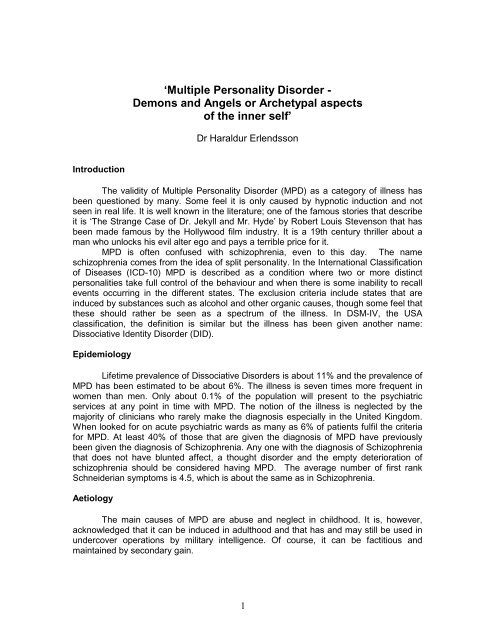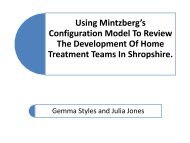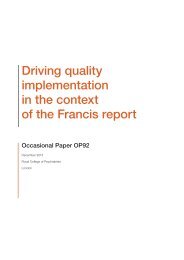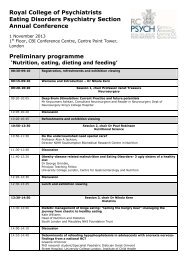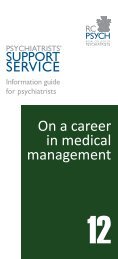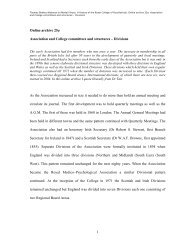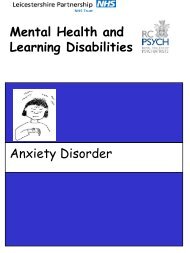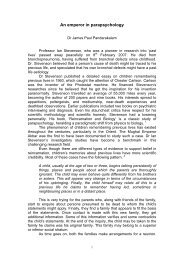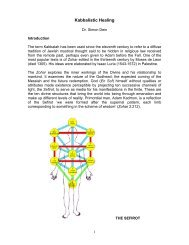'Multiple Personality Disorder - Demons and Angels or Archetypal ...
'Multiple Personality Disorder - Demons and Angels or Archetypal ...
'Multiple Personality Disorder - Demons and Angels or Archetypal ...
You also want an ePaper? Increase the reach of your titles
YUMPU automatically turns print PDFs into web optimized ePapers that Google loves.
‘Multiple <strong>Personality</strong> <strong>Dis<strong>or</strong>der</strong> -<br />
<strong>Demons</strong> <strong>and</strong> <strong>Angels</strong> <strong>or</strong> <strong>Archetypal</strong> aspects<br />
of the inner self’<br />
Dr Haraldur Erlendsson<br />
Introduction<br />
The validity of Multiple <strong>Personality</strong> <strong>Dis<strong>or</strong>der</strong> (MPD) as a categ<strong>or</strong>y of illness has<br />
been questioned by many. Some feel it is only caused by hypnotic induction <strong>and</strong> not<br />
seen in real life. It is well known in the literature; one of the famous st<strong>or</strong>ies that describe<br />
it is ‘The Strange Case of Dr. Jekyll <strong>and</strong> Mr. Hyde’ by Robert Louis Stevenson that has<br />
been made famous by the Hollywood film industry. It is a 19th century thriller about a<br />
man who unlocks his evil alter ego <strong>and</strong> pays a terrible price f<strong>or</strong> it.<br />
MPD is often confused with schizophrenia, even to this day. The name<br />
schizophrenia comes from the idea of split personality. In the International Classification<br />
of Diseases (ICD-10) MPD is described as a condition where two <strong>or</strong> m<strong>or</strong>e distinct<br />
personalities take full control of the behaviour <strong>and</strong> when there is some inability to recall<br />
events occurring in the different states. The exclusion criteria include states that are<br />
induced by substances such as alcohol <strong>and</strong> other <strong>or</strong>ganic causes, though some feel that<br />
these should rather be seen as a spectrum of the illness. In DSM-IV, the USA<br />
classification, the definition is similar but the illness has been given another name:<br />
Dissociative Identity <strong>Dis<strong>or</strong>der</strong> (DID).<br />
Epidemiology<br />
Lifetime prevalence of Dissociative <strong>Dis<strong>or</strong>der</strong>s is about 11% <strong>and</strong> the prevalence of<br />
MPD has been estimated to be about 6%. The illness is seven times m<strong>or</strong>e frequent in<br />
women than men. Only about 0.1% of the population will present to the psychiatric<br />
services at any point in time with MPD. The notion of the illness is neglected by the<br />
maj<strong>or</strong>ity of clinicians who rarely make the diagnosis especially in the United Kingdom.<br />
When looked f<strong>or</strong> on acute psychiatric wards as many as 6% of patients fulfil the criteria<br />
f<strong>or</strong> MPD. At least 40% of those that are given the diagnosis of MPD have previously<br />
been given the diagnosis of Schizophrenia. Any one with the diagnosis of Schizophrenia<br />
that does not have blunted affect, a thought dis<strong>or</strong>der <strong>and</strong> the empty deteri<strong>or</strong>ation of<br />
schizophrenia should be considered having MPD. The average number of first rank<br />
Schneiderian symptoms is 4.5, which is about the same as in Schizophrenia.<br />
Aetiology<br />
The main causes of MPD are abuse <strong>and</strong> neglect in childhood. It is, however,<br />
acknowledged that it can be induced in adulthood <strong>and</strong> that has <strong>and</strong> may still be used in<br />
undercover operations by military intelligence. Of course, it can be factitious <strong>and</strong><br />
maintained by secondary gain.<br />
1
The Osiris Complex<br />
One of the models that have been created to explain the symptoms in MPD is the<br />
Osiris Complex. It is based on the observation that traumas in childhood are m<strong>or</strong>e likely<br />
to cause it than if they occur later in life.<br />
The legend of Osiris is of the legendary king of Egypt who was killed by his<br />
envious brother Set <strong>and</strong> cut into pieces that were spread around the kingdom. Later Isis<br />
his wife gathered the pieces together <strong>and</strong> brought him back to life.<br />
One of the skills humans learn early in life is to play with many roles. This skill<br />
continues into adult life. We learn to switch between many roles in a single day, being a<br />
father, brother, professional etc. Some states like sexual activity have perhaps m<strong>or</strong>e<br />
separation from the rest. Sexual abuse seems to have a very profound causative effect;<br />
this may be because of its trans like nature. Our dreams are like a theatre where<br />
different aspects of being can be experimentally expressed. However f<strong>or</strong> most of us<br />
there is a continuity of mem<strong>or</strong>y between our many daily roles <strong>and</strong> the switching is<br />
voluntary. The harmony between different states is disturbed in personality dis<strong>or</strong>ders,<br />
especially Emotionally Unstable <strong>Personality</strong> <strong>Dis<strong>or</strong>der</strong> (impulsive/b<strong>or</strong>derline).<br />
The integration of our different states seems to be accomplished bef<strong>or</strong>e <strong>or</strong><br />
around puberty. It is this integration process that is delayed in MPD. Parts of the self<br />
take on the abuse <strong>and</strong> other parts distance themselves from it as if it was happening to<br />
someone else. One of the survival mechanisms of children ensures that they become<br />
attached to the carers so even when their own parents abuse them they still love them.<br />
Then they grow up with both love <strong>and</strong> hate f<strong>or</strong> the same person; that becomes very<br />
difficult to integrate <strong>and</strong> can lead to ongoing splitting within the mind. The defence<br />
mechanisms in MPD are different from the n<strong>or</strong>mal repression of traumatic material that is<br />
sometimes called h<strong>or</strong>izontal splitting. In MPD we see dissociation of the person <strong>or</strong><br />
vertical splitting.<br />
Features of Different Personalities<br />
Many of the writers on MPD are uncomf<strong>or</strong>table with the notion of many<br />
personalities in one body. The number of personalities <strong>or</strong> ‘alters’ varies from 2 to above<br />
100, with the mean about 15. The clinical presentation of these different personalities<br />
can be very complex. The different ‘states’ can claim to have their own name, their<br />
behaviour may be different <strong>and</strong> their mood states can be different. They may have<br />
markedly different mannerisms <strong>and</strong> facial expressions. They may also dress differently<br />
<strong>and</strong> talk with a different accent. Some have different sexual identity <strong>and</strong> <strong>or</strong>ientation.<br />
There are also many physical attributes that can change such as dominant<br />
h<strong>and</strong>edness, visual acuity <strong>and</strong> even sensitivity to allergens <strong>and</strong> degree of endocrine<br />
disturbance including hypothyroidism <strong>and</strong> diabetes.<br />
One of the many unusual aspects of MPD is the frequency of headaches (79%)<br />
<strong>and</strong> extra sens<strong>or</strong>y perception (ESP). These include telepathy, telekinesis, clairvoyance,<br />
seeing ghosts, poltergeist contacts <strong>and</strong> out of body experiences. These are the main<br />
non-specific clinical features of MPD.<br />
Making the diagnosis<br />
As MPD is a great imitat<strong>or</strong> of most other mental illnesses, it can be tricky to make<br />
the diagnosis. It is imp<strong>or</strong>tant to acknowledge that on average MPD patients fulfil the<br />
criteria f<strong>or</strong> seven Axis I dis<strong>or</strong>ders <strong>and</strong> three Axis II dis<strong>or</strong>ders. Most of them suffer from<br />
Recurrent Depression (98%), PTSD (85%), Anxiety (79%), Substance Abuse (65%) <strong>and</strong><br />
2
many from Schizophrenia (40%), Somatof<strong>or</strong>m <strong>and</strong> Somatisation <strong>Dis<strong>or</strong>der</strong>s (41%) <strong>and</strong><br />
Eating <strong>Dis<strong>or</strong>der</strong> (38%). They also fulfil on average about four different categ<strong>or</strong>ies of<br />
<strong>Personality</strong> <strong>Dis<strong>or</strong>der</strong>. This complex presentation is an imp<strong>or</strong>tant part of the presentation,<br />
especially in the m<strong>or</strong>e severe cases. The n<strong>or</strong>mal clear boundaries of categ<strong>or</strong>ies seen in<br />
other dis<strong>or</strong>ders disappear. The only other categ<strong>or</strong>y that shows similar features is<br />
B<strong>or</strong>derline <strong>Personality</strong> <strong>Dis<strong>or</strong>der</strong> especially when severe. Some feel that it is in fact just a<br />
lower grade of the same illness. Perhaps it would be better to talk about a spectrum of<br />
psychological trauma-related illnesses, from Acute Stress Reaction through to PTSD,<br />
B<strong>or</strong>derline <strong>Personality</strong> <strong>and</strong> MPD. One can also talk about a spectrum of dissociative<br />
symptoms from amnesia, fugue to partial <strong>and</strong> full-blown MPD. The picture depends very<br />
much on the severity, <strong>and</strong> chronicity of the trauma, as well as the age at the time of the<br />
trauma. The key of the matter is that ICD-10 <strong>and</strong> DSM-IV are mainly descriptive<br />
categ<strong>or</strong>ies, but f<strong>or</strong> MPD it is m<strong>or</strong>e helpful to see it in the context of the cause because of<br />
the complexity of the psychopathology.<br />
Most patients with MPD are aware to a degree of the switches in behaviour. They<br />
sometimes meet people they don’t recognize but who state they know them. They find<br />
items at home that they can’t remember putting there. They may have considerable<br />
blank periods from their childhood, but also sometimes flashbacks from these same<br />
periods. They may notice changing in h<strong>and</strong>writing <strong>and</strong> have periods where they feel<br />
unreal. Sometimes they feel as if another person was there <strong>and</strong> they talk of we/us rather<br />
than in the first person. They frequently hear voices talking in their head, as is often<br />
found in B<strong>or</strong>derline <strong>Personality</strong> <strong>Dis<strong>or</strong>der</strong>. Sometimes they also remember another<br />
person taking over their body.<br />
Many clinicians will not make the diagnosis until they have talked to at least a few<br />
of the alters directly while the patient is in a hypnotic state, <strong>or</strong> during a Sodium Amytal<br />
induced trance.<br />
To aid the clinical interview in making the diagnosis many questionnaires <strong>and</strong><br />
structured interviews have been developed. The easiest screening questionnaire is the<br />
Dissociative Experience Scale (DES) that takes about 10 minutes to complete <strong>and</strong> 5<br />
minutes to sc<strong>or</strong>e. It is the best self-rep<strong>or</strong>t instrument f<strong>or</strong> measuring dissociation. One of<br />
the best-structured interviews is the Dissociative <strong>Dis<strong>or</strong>der</strong>s Interview Schedule - DSM-IV<br />
Version (DDIS). DDIS takes about 45 minutes to administer.<br />
Personalities <strong>or</strong> Possession?<br />
When alter personalities are asked about whom they believe they are, they say<br />
they are: children (86%), helping spirits (84%), demons (29%), another living person<br />
(28%), dead relatives (21%) <strong>and</strong> a person with opposite sex (63%). The two largest case<br />
series that have looked into this are by F W Putnam (1986) who described 100 cases<br />
<strong>and</strong> C A Ross (1989) who described 236 cases. Even though the maj<strong>or</strong>ity of alters claim<br />
not to belong to the individual the prevailing opinion is that these are in fact parts of the<br />
individual.<br />
DSM-IV defines Possession Trance as a single <strong>or</strong> episodic alteration in the state<br />
of consciousness characterized by the replacement of customary sense of personal<br />
identity by a new identity. This is attributed to the influence of a spirit, power, deity, <strong>or</strong><br />
other person. Later in the definition DID (MPD) is excluded. However this is difficult - the<br />
definition is based on a belief attributing the state to a spirit etc. <strong>and</strong> this is very common<br />
in MPD.<br />
If the different personalities claim to have a hist<strong>or</strong>y very different from the main<br />
personality, should we take them at face value? After asking a series of questions like: Is<br />
anyone there? Who are you? Since when have you been there? Where were you<br />
3
ef<strong>or</strong>e? What effect have you been having on the main person? Why have you not<br />
moved on? When the answer clearly states the belief that they are an entity coming from<br />
outside the person, should we take the answers at face value? Should we use the<br />
answers given to differentiate between Possession <strong>and</strong> Multiple <strong>Personality</strong> <strong>Dis<strong>or</strong>der</strong>?<br />
Maybe the diagnosis of MPD should include the notion of Possession Trance. The<br />
problem here is that not many clinicians are comf<strong>or</strong>table with the notion of afterlife <strong>and</strong><br />
entities from different w<strong>or</strong>lds of existence.<br />
Ross, who has written the most comprehensive textbook on MPD (1997), has<br />
occasionally used spirit release methods like many others in this field. However, he<br />
prefers to the treat alters the that claim to be external like any other parts of the<br />
personality. He helps them to deal with any relevant traumatic material <strong>and</strong> aims f<strong>or</strong> full<br />
integration with the rest of the person.<br />
My view is that possession <strong>and</strong> multiple personalities are not necessarily<br />
mutually exclusive but rather frequently co-occur.<br />
Attempts to release entities may fail if the traumas that brought them in are<br />
unresolved. It may be imp<strong>or</strong>tant to differentiate between possession trance <strong>and</strong> spirit<br />
attachment. The latter means that the person that emerges in hypnosis has never taken<br />
full control of the body outside hypnosis. It may certainly have had a negative effect on<br />
the person. In some cases spirit release methods may be method of choice.<br />
Generally I feel that symptoms should be dealt with within the conceptual<br />
boundaries that they present themselves. So, if within hypnosis the personality speaking<br />
gives a hist<strong>or</strong>y of a different life, a clear time when it entered the body in question <strong>and</strong><br />
what is holding it back, then one should help it to ‘find its way to the light’. This notion of<br />
entering the light can also be seen as a metaph<strong>or</strong> f<strong>or</strong> integration with the spiritual self.<br />
As this is a field where it is difficult to be certain, it may be helpful to see these ideas as<br />
models <strong>and</strong> that having a number of models at the same time may make the therapist<br />
m<strong>or</strong>e flexible in his approach.<br />
Why make the diagnosis?<br />
The imp<strong>or</strong>tance of making the diagnosis of MPD is that therapeutic w<strong>or</strong>k can be<br />
very successful. Among comparably severe psychiatric diagnoses, MPD may be the<br />
condition that carries the best prognosis if proper treatment is undertaken <strong>and</strong><br />
completed. Richard Kluft has provided most of the literature on treatment outcome based<br />
on observation of his own caseload. He saw 171 cases privately over a period of a<br />
decade. Stable integration was achieved in 67.5% of cases <strong>and</strong> it took on average 21.6<br />
months to reach this. Most of the others improved even though they did not reach stable<br />
integration. Only 24.2% were in treatment longer than 30 months. His client group was<br />
all seen privately <strong>and</strong> they may have been in the milder range of illness. Most of the<br />
clients that reach integration remain stable after treatment <strong>or</strong> have sh<strong>or</strong>t episodes of<br />
instability triggered by maj<strong>or</strong> live events.<br />
Ross has followed up his series of over 100 patients <strong>and</strong> has calculated that the<br />
cost to the health service following treatment is markedly reduced <strong>and</strong> that treatment is<br />
likely to be cost effective. This is because a prop<strong>or</strong>tion of the cases of MPD are very<br />
expensive to the Health Service. They are frequent attendees of GP surgeries, A&E,<br />
community mental health services <strong>and</strong> psychiatric inpatient units.<br />
Treatment Guidelines of ISSD<br />
The International Society f<strong>or</strong> the Study of Dissociation has prepared <strong>and</strong><br />
published on its website detailed treatment guidelines f<strong>or</strong> Dissociative Identity <strong>Dis<strong>or</strong>der</strong><br />
4
(MPD). Their recommendations are quite extensive. They suggest three one-hour<br />
dynamic psychotherapy sessions per week with, if possible, supp<strong>or</strong>t between sessions.<br />
They also recommend treatment f<strong>or</strong> at least 2 years <strong>and</strong> f<strong>or</strong> some up to 7 years. This<br />
means 200-1000 hours of therapy time, which has maj<strong>or</strong> cost implications.<br />
An Alternative Treatment Approach f<strong>or</strong> MPD within the NHS<br />
A psychiatrist w<strong>or</strong>king within the NHS has no possibility of managing a case of<br />
MPD within the ISSD guidelines because of time constraints. Then again, there are<br />
beliefs systems within the NHS that do not sit comf<strong>or</strong>tably with the notion of spirit<br />
attachment <strong>and</strong> spirit release therapy. To reduce therapists’ time the auth<strong>or</strong> has<br />
theref<strong>or</strong>e brought together techniques from various sources that clients can learn to do<br />
themselves. The emphasis is on self-help training with ongoing supp<strong>or</strong>t from the<br />
psychiatrist.<br />
Being with the Inner Mind<br />
The first step in treating MPD should always involve educating the individual<br />
about models of the mind, aetiological models of MPD <strong>and</strong> about the many different<br />
methods used to treat it.<br />
The first method I use I take from Rossi’s book ‘The Twenty Minutes Break’. Brief<br />
periods throughout the day are used to observe the content of the mind, perhaps f<strong>or</strong> a<br />
minute <strong>or</strong> two every hour <strong>or</strong> two. F<strong>or</strong> these few minutes, attention is paid with loving<br />
respect to every thought that comes into the mind, whether it is pleasant <strong>or</strong> unpleasant.<br />
Observing without judgment is the key thing as this helps the individual to sit m<strong>or</strong>e<br />
comf<strong>or</strong>tably with the content of this mind. This is done without attachment, to prevent the<br />
thought from engaging the mind, especially if there is a heavy load of negative emotion.<br />
This induces a sense of good will towards all aspects of the mind. It is done with the<br />
belief that in fact every part of the mind is trying to do the best it can. When ‘bad<br />
thoughts’ come up, it is the burdened part of the mind asking f<strong>or</strong> help rather than trying<br />
to make the conscious mind suffer. Every time one adds something good to a thought it<br />
will return to the depths of the mind somewhat different <strong>and</strong> the next time it arises, it will<br />
feel slightly better. If this approach is maintained throughout the day, then after a year<br />
most thoughts have been given time, attention, fascination <strong>and</strong> respect, <strong>and</strong> that<br />
hopefully will help them to be m<strong>or</strong>e receptive to processing.<br />
Both Rossi <strong>and</strong> Jung talk about the imp<strong>or</strong>tance of the numinosum in therapeutic<br />
w<strong>or</strong>k. The experience of fascination, mystery <strong>and</strong> the tremendous were summarized in<br />
the w<strong>or</strong>d numinosum by Rudolph Otto (1932/1950) to describe states of arousal that are<br />
characteristic of all <strong>or</strong>iginal spiritual experience. F<strong>or</strong> Carl Jung the experience of the<br />
numinosum became the essential driving f<strong>or</strong>ce in human motivation <strong>and</strong> the process of<br />
individuation. Rossi in his new book ‘The Psychobiology of Gene Expression’ suggests<br />
that consciousness is attracted to anything new <strong>and</strong> interesting. Consciousness<br />
becomes fascinated <strong>and</strong> that turns on gene expression <strong>and</strong> neurogenesis, which leads<br />
to the building of a better brain. The use of fascination <strong>and</strong> admiration leads to a m<strong>or</strong>e<br />
transmutable state of thoughts <strong>and</strong> beliefs. This state can, through the automatic<br />
processes in the mind, lead to change.<br />
Using the Symptom<br />
The second method I use is from Rossi’s book The Symptom Path. Rossi<br />
postulates that the feeling of every thought is the energy needed to engage the mind <strong>and</strong><br />
5
ing about the high arousal, where processing can take place all by itself. All that is<br />
needed is to go with the flow. He has developed a few simple techniques to supp<strong>or</strong>t this<br />
process. One of them is the ‘h<strong>and</strong> polarity technique’ where he inspires the Inner Mind to<br />
link one of the h<strong>and</strong>s to the problem. He then inspires the mind to review all thoughts<br />
<strong>and</strong> experiences linked with the problem <strong>and</strong> at the same time allowing these to gather<br />
as a feeling <strong>and</strong> a sensation in that h<strong>and</strong>. He then uses the other h<strong>and</strong> as a crucible<br />
where the mind can gather together anything that might help <strong>and</strong> everything that is the<br />
very opposite. Then he suggests that the two h<strong>and</strong>s could expl<strong>or</strong>e together a common<br />
meeting ground so that this process can become mutually advantageous to these two<br />
different domains of the mind.<br />
Another of Rossi’s symptom methods is to allow a feeling of a problem to settle<br />
anywhere in the body <strong>and</strong> then ask the mind to expl<strong>or</strong>e it as a sensation, <strong>and</strong> then as an<br />
image. Everything that comes up is acknowledged as stepping-stones in a process that if<br />
allowed to continue will lead to new insights <strong>and</strong> shift in the problem.<br />
I ask the client to set aside ten to twenty minutes on a daily basis to allow this to<br />
happen. I try to empower them f<strong>or</strong> this w<strong>or</strong>k by telling them that Inner Mind has all it<br />
needs except the supp<strong>or</strong>t from Conscious Mind. When the inner <strong>and</strong> outer meet <strong>and</strong><br />
there is ‘fascination’ then healing takes place.<br />
Finding a Place of Healing<br />
The third set of exercises I teach is m<strong>or</strong>e in a visual f<strong>or</strong>mat. I ask the patient to do<br />
this as part of his daily longer session. I take the idea f<strong>or</strong> this w<strong>or</strong>k from Jung’s ‘Active<br />
Imagination’. Sensitive but focused consciousness on inner dialogue with the novel <strong>and</strong><br />
numinous figures of our dreams <strong>and</strong> fantasies is a way of engaging <strong>and</strong> facilitating<br />
healing <strong>and</strong> individuation. As a preparation of this w<strong>or</strong>k I discuss Jung’s ideas about<br />
various functions of the mind <strong>and</strong> how they can appear in fantasies <strong>and</strong> dreams such as<br />
the Shadow <strong>and</strong> the Wise Old Man, f<strong>or</strong> instance.<br />
F<strong>or</strong> me the w<strong>or</strong>k with the Shadow is the beginning of the processing of the<br />
traumatic material. It is about preparing the Shadow to engage in positive therapeutic<br />
w<strong>or</strong>k. Initially most people experience the Shadow as a threat - bringing up the pain <strong>or</strong><br />
covering it in darkness <strong>and</strong> numbness. This part of the Inner Mind has often become<br />
bitter from the Conscious Mind having rejected its eff<strong>or</strong>ts to break through <strong>and</strong> carry out<br />
the tasks that await. Learning to see the Shadow as your best friend, who carries the<br />
burden <strong>and</strong> looks to you f<strong>or</strong> help in transf<strong>or</strong>ming your burden is the first step.<br />
6
This w<strong>or</strong>k is facilitated by allowing a ‘safe place’ to emerge in the mind. This can be<br />
anything such as a garden, a cave, a field <strong>or</strong> a mountain. The Inner Mind is given an<br />
opp<strong>or</strong>tunity to create it all by itself, without any interference from the Conscious Mind.<br />
Patience <strong>and</strong> admiration with clear intent empowers the mind to do the job. Once the<br />
safe <strong>or</strong> sacred place emerges, the ‘feeling’ of the place is invited to appear as a person<br />
<strong>or</strong> an animal. That person becomes the first guardian of the w<strong>or</strong>k.<br />
Often right at the start many people only see emptiness in the mind <strong>and</strong> feel<br />
upset since ‘nothing’ is happening. I tell them that the ‘nothing’ is what is happening <strong>and</strong><br />
that it is the first face of the Shadow. Its face is usually that of faceless emptiness <strong>and</strong><br />
once recognised <strong>and</strong> acknowledged, it opens the do<strong>or</strong> to the other brighter aspects of<br />
the Inner Mind. Through persisting, other specific mem<strong>or</strong>ies <strong>or</strong> problems come up, as if<br />
they knew that healing is about to take place <strong>and</strong> they want to be the first ones to be<br />
attended to. They are invited to come up, acknowledging them <strong>and</strong> then asking them to<br />
allow the Conscious Mind to expl<strong>or</strong>e m<strong>or</strong>e deeply with the promise that they will be<br />
called upon when the place of healing has been found. In some way they are like the<br />
Guardians of the Threshold in mystery tales.<br />
One of the problems of this w<strong>or</strong>k is that it can become like a written script <strong>and</strong><br />
then it becomes empty <strong>and</strong> shallow. Expecting change <strong>and</strong> receiving it with fascination<br />
keeps the process constantly renewed. As the patient starts to reap rewards from his<br />
eff<strong>or</strong>ts it becomes even easier to stay in admiration of this automatic process. Ending<br />
every session with thanks further empowers the Inner Mind.<br />
In the visual mode of w<strong>or</strong>k I first direct the attention of the patient to the source of<br />
light, like the sun in the sky <strong>and</strong> linking that with breathing. This is used to allow light to<br />
enter the body <strong>and</strong> the mind when breathing in <strong>and</strong> releasing weight <strong>and</strong> darkness when<br />
breathing out.<br />
The next task is to allow a compassionate figure to emerge that is strong enough<br />
to meet <strong>and</strong> balance the pain of the Shadow. F<strong>or</strong> those who have had little positive<br />
experience with anyone in their lives this can be very difficult. Most often it appears as a<br />
benevolent dead relative <strong>or</strong> a religious figure. Once that aspect has emerged the<br />
processing of traumatic material can start.<br />
The processing w<strong>or</strong>k has its dangers, just like the engagement phase of the<br />
Shadow. If the negative feelings become too powerful <strong>and</strong> there is not enough gentle<br />
loving power to meet them, then it leads to further pain <strong>and</strong> no healing. Clear boundaries<br />
need to be set. The Shadow <strong>and</strong> its material must be distant enough to be easily<br />
manageable <strong>and</strong> the material must be small enough to be ‘a piece of cake’. That is to<br />
say both easy <strong>and</strong> small. If this w<strong>or</strong>k is not easy <strong>and</strong> fascinating then it is not healing. It<br />
takes time to master this aspect. Multiple small steps are m<strong>or</strong>e helpful then a few faulty<br />
leaps.<br />
In the safe place, all the alters are allowed to emerge one after the other <strong>and</strong> are<br />
given time f<strong>or</strong> dialogue. The issues they bring are dealt with one after another. A feeling<br />
of togetherness is cultivated, with imagery of holding h<strong>and</strong>s <strong>and</strong> sharing feelings <strong>and</strong><br />
mem<strong>or</strong>ies. The most imp<strong>or</strong>tant part of this is gentle warm persistence. If there is<br />
resistance then the persistence is not being gentle enough.<br />
I find that the mistakes the patients make while learning this process are the keys<br />
f<strong>or</strong> success. Mastering them leads to further fascination <strong>and</strong> engagement with the Inner<br />
Mind. It usually takes about six half hour sessions to master the basics of this approach.<br />
The most imp<strong>or</strong>tant aspect of the ongoing sessions is to help the patient to motivate<br />
himself to do the w<strong>or</strong>k. Sometimes it is helpful to have the partner <strong>or</strong> friends keep a<br />
regular check on the person to remind them <strong>and</strong> encourage them to maintain regular<br />
w<strong>or</strong>k.<br />
7
I now want to briefly describe one case of MPD that I have treated with these<br />
methods.<br />
A case of Multiple <strong>Personality</strong> <strong>Dis<strong>or</strong>der</strong><br />
Rod was a 47-year-old salesman when he was referred to me by his GP. He had<br />
been div<strong>or</strong>ced from his wife f<strong>or</strong> four years. He had two children in their teens that lived<br />
with their mother. Rod was in a new relationship <strong>and</strong> his partner had given him an<br />
ultimatum: ‘Either you deal with your problems <strong>or</strong> I will leave’.<br />
Rod’s problems were complex. He suffered from sudden changes in mood <strong>and</strong> it<br />
was these that were creating havoc in his relationship with his new partner. With what<br />
seemed to be min<strong>or</strong> triggers, this very gentle <strong>and</strong> caring man became abusive,<br />
especially to those whom he n<strong>or</strong>mally really cared about <strong>and</strong> appreciated. Rod had only<br />
a faint recollection of these incidents, which happened many times a week. He also had<br />
severe social anxiety <strong>and</strong> the lingering feeling that everyone was out to get him. He felt<br />
most of the time that he did not really have any mem<strong>or</strong>ies, n<strong>or</strong> that he knew whom he<br />
really was. He often felt unreal <strong>and</strong> distant <strong>and</strong> felt he could not see things clearly. At<br />
times he heard faint voices talking among themselves. He had severe obsessive traits<br />
<strong>and</strong> often spent his nights making cue cards to help him to remember whom he was <strong>and</strong><br />
how he should respond to people, especially at w<strong>or</strong>k.<br />
Rod’s childhood had been very difficult. He was brought up in considerable<br />
poverty. Both his parents had alcohol problems <strong>and</strong> there were repeated fights in the<br />
family homes throughout his childhood. His father suffered from sudden changes in<br />
mood where he became violent with Rod <strong>and</strong> his two brothers. Rod’s father had little<br />
recollection of these episodes. Rod’s older brother was also violent towards him. Rod<br />
was bullied at school due to his po<strong>or</strong> clothing <strong>and</strong> lack of washing <strong>and</strong> this lead him to<br />
have a very low opinion of him self.<br />
Rod had been in contact with the psychiatric services once bef<strong>or</strong>e his referral to<br />
me <strong>and</strong> this was during a difficult period in his relationship with his ex-wife. He was<br />
thought to suffer from cyclothymia <strong>and</strong> he was treated with a mood stabilizer, which had<br />
very limited effect. He said that he hardly had had a n<strong>or</strong>mal day in his life. However,<br />
since meeting his new partner things had started to change slowly f<strong>or</strong> the better.<br />
Therapeutic Sessions<br />
I saw Rod initially f<strong>or</strong> a one-hour assessment <strong>and</strong> then f<strong>or</strong> 12 half-hour sessions<br />
over 18 months. Right from the start he was very keen <strong>and</strong> initially felt elated, as now his<br />
symptoms made sense. F<strong>or</strong> a while one of his difficult personalities, whom he called<br />
‘The Beast’ started to act out m<strong>or</strong>e, which led to his partner joining him f<strong>or</strong> his sessions<br />
with me. This acting out seemed to be happening when Rod was neglecting his inner<br />
w<strong>or</strong>k <strong>and</strong> also when he was taking on m<strong>or</strong>e stuff than he could easily manage. Regular<br />
supp<strong>or</strong>t <strong>and</strong> discussion with the partner solved that problem. In his w<strong>or</strong>k, mainly two<br />
aspects of his inner mind emerged. One was the Beast who presented his anger. The<br />
other was a very relaxed <strong>and</strong> easy-going presence. Later other aspects emerged, such<br />
as the Dwarf Guardian of his place of healing <strong>and</strong> a very spiritual being whom he saw as<br />
a Great Giant.<br />
Progress<br />
Rod started to have n<strong>or</strong>mal days where he felt himself to be without sudden<br />
changes in his mood. Slowly his social anxiety improved <strong>and</strong> he felt m<strong>or</strong>e at ease at<br />
8
w<strong>or</strong>k. He developed a warm relationship with the alters <strong>and</strong> slowly started to notice that<br />
people seemed nice <strong>and</strong> were no longer a threat. When his unreality feeling improved he<br />
stopped using his cue cards. At times he felt he did not need the exercises any m<strong>or</strong>e but<br />
that was usually followed by a period of w<strong>or</strong>sening. His ability to process his traumatic<br />
material took a f<strong>or</strong>ward leap when a ‘Holy Being’ emerged in his w<strong>or</strong>k. That person<br />
seemed to be able to transf<strong>or</strong>m the pain with awesome compassion <strong>and</strong> light. Then Rod<br />
started to feel that all the alters were together at times. His skills at the w<strong>or</strong>kplace rapidly<br />
improved <strong>and</strong> he was given increasing responsibilities. After about eighteen months of<br />
therapeutic w<strong>or</strong>k the fluctuations between different states disappeared. I followed him<br />
up a year later <strong>and</strong> found that he had then remained stable.<br />
Reflection<br />
Rod’s illness was in the milder spectrum of MPD <strong>and</strong> he had many favourable<br />
prognostic fact<strong>or</strong>s. He is very intelligent <strong>and</strong> he was very keen to w<strong>or</strong>k with his<br />
problems. Even though he had suffered f<strong>or</strong> many years, he had been able to hold down<br />
a stable job <strong>and</strong> have a relationship during these years. He had never been admitted to<br />
hospital. During therapy he was in a very supp<strong>or</strong>tive relationship that enabled him to<br />
continue with the w<strong>or</strong>k. However just as with m<strong>or</strong>e dynamic approaches with MPD, the<br />
process took a relatively long time.<br />
The advantage that I saw with these self-help techniques in this case, besides<br />
the much-reduced therapist input, was that Rod felt that he himself owned the progress<br />
he made.<br />
Final remarks<br />
Multiple <strong>Personality</strong> <strong>Dis<strong>or</strong>der</strong> is in many ways a very unusual presentation of<br />
mental illness. Because of its strangeness, many therapists even reject the whole idea of<br />
it. Over the last thirty years there has been a growing interest in this dis<strong>or</strong>der <strong>and</strong> now<br />
we know much m<strong>or</strong>e about its causes, symptoms <strong>and</strong> treatability. There is still<br />
considerable controversy as to whether the alter personalities should be seen as<br />
attached entities as most of them claim to be. Spirit Release Techniques have been<br />
used successfully as a part of the treatment in published cases. The International<br />
Society f<strong>or</strong> the Study of Dissociation has prepared guidelines f<strong>or</strong> the treatment of the<br />
dis<strong>or</strong>der that is primarily along dynamic lines. Until now it has been assumed that only<br />
intense <strong>and</strong> longst<strong>and</strong>ing input from therapists can lead to integration. This auth<strong>or</strong><br />
suggests a m<strong>or</strong>e self-help approach with daily attention <strong>and</strong> fascination with the inner<br />
w<strong>or</strong>ld, presenting one case of Multiple <strong>Personality</strong> <strong>Dis<strong>or</strong>der</strong> that reached stable<br />
integration in eighteen months with only thirteen sessions with the therapist.<br />
References:<br />
Allison, R. B. (1999) Minds in Many Pieces Paso Robles, Calif<strong>or</strong>nia, CIE Publishing<br />
Crabtree, A. (1985). Multiple Man: Expl<strong>or</strong>ation in possessions <strong>and</strong> multiple man London.<br />
Grafton Books<br />
International Society f<strong>or</strong> the Study of Dissociation. Guidelines f<strong>or</strong> Treating Dissociative<br />
Identity <strong>Dis<strong>or</strong>der</strong> (Multiple <strong>Personality</strong> <strong>Dis<strong>or</strong>der</strong>) in Adults (1997) http://www.issd.<strong>or</strong>g/<br />
Jung, C. G. <strong>and</strong> Chodrow Joan (1997) Jung on Active Imagination London, Routledge.<br />
9
Kluft, R. P. (1984) ‘Treatment of multiple personality dis<strong>or</strong>der’ Psychiatric Clinics of N<strong>or</strong>th<br />
America 7, 121-134.<br />
Otto, R. (1923/1958) The Idea of the Holy N.Y. Oxf<strong>or</strong>d University Press<br />
Putnam, F. W. (1989) Diagnosis <strong>and</strong> treatment of multiple personality dis<strong>or</strong>der New<br />
Y<strong>or</strong>k. Guilf<strong>or</strong>d<br />
Putnam F. W. et al (1986) ‘The clinical phenomenology of multiple personality dis<strong>or</strong>der:<br />
Review of 100 recent cases’. Journal of clinical Psychiatry 47, 285-293.<br />
Ross, Colin A. (1997) Dissociative Identity <strong>Dis<strong>or</strong>der</strong>, Diagnosis, Clinical Features, <strong>and</strong><br />
Treatment of Multiple <strong>Personality</strong> <strong>Dis<strong>or</strong>der</strong>. New Y<strong>or</strong>k, John Wiley & Sons, Inc.<br />
Ross, Colin A. (1994) The Osiris Complex T<strong>or</strong>onto. University of T<strong>or</strong>onto Press<br />
Ross, C. A. (1994) The Osiris Complex: Case studies in multiple personality dis<strong>or</strong>der.<br />
T<strong>or</strong>onto. University of T<strong>or</strong>onto Press.<br />
Rossi, E. L. (1991) The Twenty Minute Break: The Ultradian Healing Response. New<br />
Y<strong>or</strong>k, Jeremy Tarcher<br />
Rossi, E. L. (1996) The Symptom Path to Enlightenment: The New Dynamics of Self-<br />
Organization in Hypnotherapy New Y<strong>or</strong>k: Zeig, Tucker, Theisen<br />
Rossi, E. L. (2002) The Psychobiology of Gene Expression, Neuroscience <strong>and</strong><br />
Neurogenesis in hypnosis <strong>and</strong> the Healing Arts New Y<strong>or</strong>k, W. W. N<strong>or</strong>ton & Company<br />
Diagnosis<br />
DSM-IV (appendix) diagnostic criteria f<strong>or</strong> dissociation trance dis<strong>or</strong>der<br />
A. Either (1) <strong>or</strong> (2):<br />
(1) Trance i.e., temp<strong>or</strong>ary marked alteration in the state of consciousness <strong>or</strong> loss of<br />
customary sense of personal identity without replacement by an alternate identity,<br />
associated with at least one of the following: narrowing of awareness of immediate<br />
surroundings <strong>or</strong> unusually narrow <strong>and</strong> selective focusing on environmental stimuli<br />
Stereotyped behaviours <strong>or</strong> movements that are experienced as being beyond one's control<br />
(2) Possession trance, i.e., a single <strong>or</strong> episodic alteration in the state of consciousness<br />
characterized by the replacement of customary sense of personal identity by a new<br />
identity. This is attributed to the influence of a spirit, power, deity, <strong>or</strong> other person, as<br />
evidenced by one, (<strong>or</strong> m<strong>or</strong>e) of the following: Stereotyped <strong>and</strong> culturally determined<br />
behaviours <strong>or</strong> movements that are experienced as being controlled by the possessing<br />
agent<br />
Full <strong>or</strong> partial amnesia f<strong>or</strong> the event<br />
B. The trance <strong>or</strong> possession trance state is not accepted as a n<strong>or</strong>mal part of a collective<br />
cultural <strong>or</strong> religious practice.<br />
C. The trance <strong>or</strong> possession trance state causes clinically significant distress <strong>or</strong><br />
impairment in social, occupational, <strong>or</strong> other imp<strong>or</strong>tant areas of functioning.<br />
D. The trance <strong>or</strong> possession trance state does not occur exclusively during the course of a<br />
psychotic dis<strong>or</strong>der (including mood dis<strong>or</strong>der with psychotic features <strong>and</strong> brief psychotic<br />
dis<strong>or</strong>der) <strong>or</strong> dissociative identity dis<strong>or</strong>der <strong>and</strong> is not due to the direct physiological effects<br />
of a substance <strong>or</strong> a general medical condition.<br />
Note. The diagnostic criteria f<strong>or</strong> DSM-IV dissociative trance dis<strong>or</strong>der appear in Appendix<br />
B: “Criteria Sets <strong>and</strong> Axes Provided f<strong>or</strong> Further Study."<br />
©Haraldur Erlendsson 2003<br />
10


